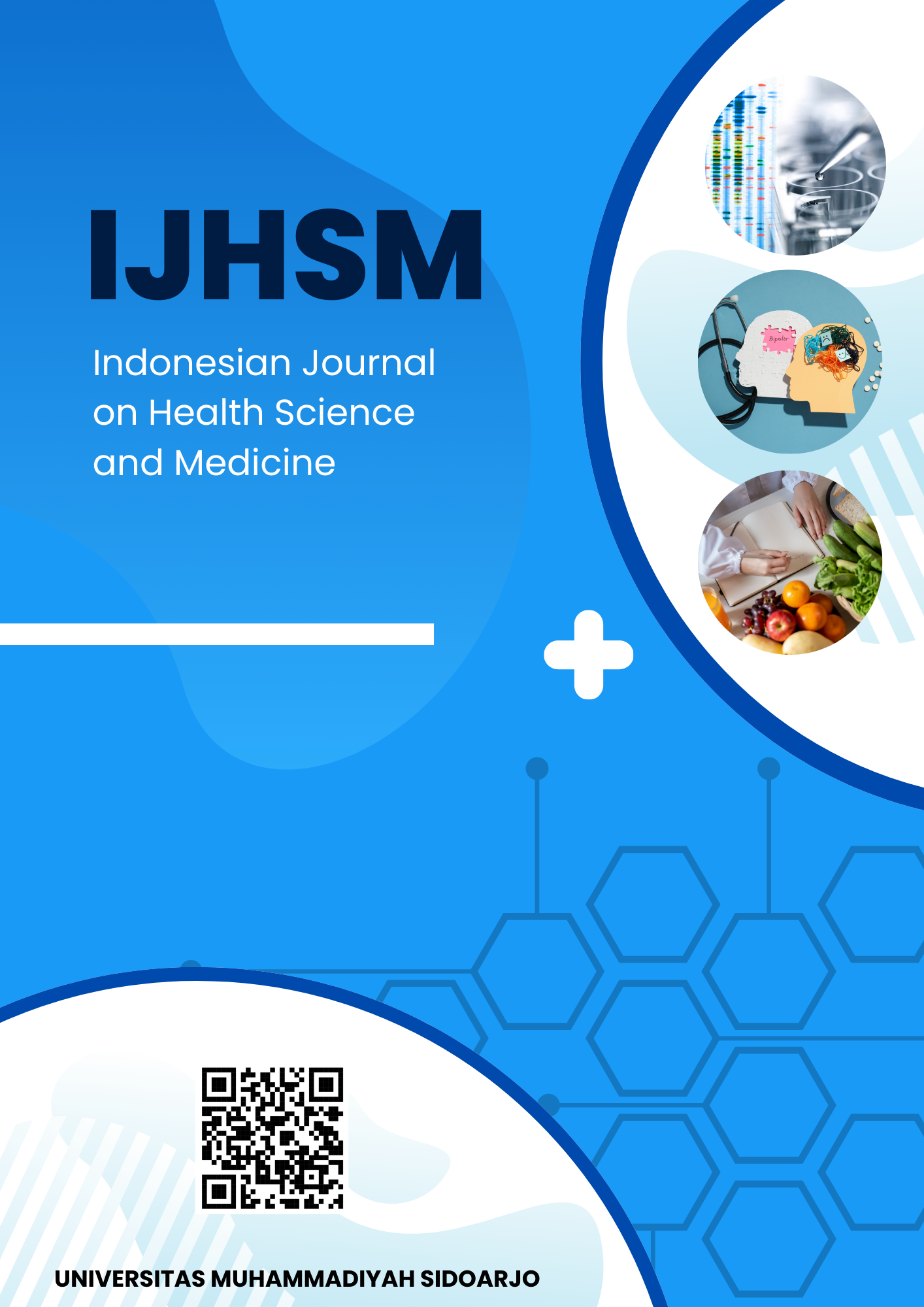Monocyte Levels, Education, and Consanguinity Associated With Miscarriage Risk
Tingkat Monosit, Pendidikan, dan Konsanguitas Berhubungan dengan Risiko Keguguran
Keywords:
Miscarriage, Monocytes, Consanguinity, Educational Level, Hematological ParametersAbstract
Background: Miscarriage remains a major public health concern with multifactorial etiology encompassing biological, social, and environmental influences. Specific Background: While numerous studies have examined hormonal, chromosomal, and nutritional contributors, the role of hematological and socio-demographic factors such as monocyte activity, consanguinity, and education level is underexplored. Knowledge Gap: The diagnostic and predictive significance of these variables in spontaneous abortion remains unclear. Aim: This study aimed to investigate the association between miscarriage and hematological parameters—particularly monocyte and platelet counts—as well as consanguinity and educational status. Results: Analysis of 100 participants (50 miscarriage cases and 50 controls) revealed a statistically significant elevation in monocyte count (P = 0.004) among miscarriage cases, while other parameters such as platelet count, RBC, Hb, and MCV showed no significant differences. Additionally, consanguinity (P = 0.04) and lower education levels (P = 0.026) were significantly associated with miscarriage incidence. Novelty: The study provides novel evidence supporting monocyte elevation and socio-demographic risks as contributory factors in miscarriage. Implications: These findings suggest the potential for monocyte levels and socio-educational context to serve as supplementary markers for miscarriage risk, advocating for integrated hematological and socio-demographic screening in early prenatal care.
Highlights:
- Monocyte elevation was significantly linked to miscarriage cases, suggesting a possible inflammatory response.
- Consanguineous marriage showed a statistically significant association with higher miscarriage rates.
- Low educational attainment was strongly correlated with increased risk of miscarriage, highlighting the role of socio-demographic factors.
Keywords: Miscarriage, Monocytes, Consanguinity, Educational Level, Hematological Parameters
References
[1] S. W. Groth et al., "Biological Changes in the Pregnancy‐Postpartum Period and Subsequent Cardiometabolic Risk—UPSIDE MOMS: A Research Protocol," Res. Nurs. Health, vol. 44, no. 4, pp. 608–619, Aug. 2021, doi: 10.1002/nur.22150.
[2] S. M. Blumenstock and J. S. Barber, "Sexual Intercourse Frequency During Pregnancy: Weekly Surveys Among 237 Young Women From a Random Population-Based Sample," J. Sex. Med., vol. 19, no. 10, pp. 1524–1535, Oct. 2022, doi: 10.1093/jsxmed/qdac014.
[3] P. Ebadi, K. Solhjoo, K. Bagheri, and F. Eftekhar, "Seroprevalence of Toxoplasmosis in Women With Recurrent Spontaneous Abortion in Comparison With Normal Delivery," Pars J. Med. Sci., vol. 9, no. 1, pp. 33–37, 2022, doi: 10.29252/jmj.9.1.33.
[4] M. D. Pettker, "ACOG Practice Bulletin," Obstet. Gynecol., vol. 135, no. 6, pp. e237–e248, Jun. 2020, doi: 10.1097/AOG.0000000000003891.
[5] R. Ahmadi, S. Ziaei, and S. Parsay, "Association Between Nutritional Status With Spontaneous Abortion," Int. J. Fertil. Steril., vol. 10, no. 4, pp. 337–342, Jan. 2016, doi: 10.22074/ijfs.2016.4918.
[6] A. J. Kember et al., "Impact of Maternal Posture on Fetal Physiology in Human Pregnancy: A Narrative Review," Front. Physiol., vol. 15, p. 1394707, 2024, doi: 10.3389/fphys.2024.1394707.
[7] S. K. Lee et al., "An Imbalance in Interleukin-17-Producing T and Foxp3+ Regulatory T Cells in Women With Idiopathic Recurrent Pregnancy Loss," Hum. Reprod., vol. 26, no. 11, pp. 2964–2971, Nov. 2011, doi: 10.1093/humrep/der301.
[8] S. Sultana, P. Nallari, and V. Ananthapur, "Recurrent Pregnancy Loss (RPL): An Overview," J. Women's Health Dev., vol. 3, no. 3, pp. 302–315, 2020.
[9] H. Y. Lee et al., "The Effect of Overweight on the Luteinizing Hormone Level After Gonadorelin Stimulation Test in Girls With Idiopathic Central Precocious Puberty," Ann. Pediatr. Endocrinol. Metab., vol. 23, no. 4, pp. 215–220, Dec. 2018, doi: 10.6065/apem.2018.23.4.215.
[10] S. G. Khader and H. F. Okab, "Assessment of Glucose Metabolism in Thalassemia Patients With Type Two Diabetes in Thi-Qar/Southern of Iraq," Int. J. Health Sci., vol. 6, no. S8, pp. 2929–2935, 2022, doi: 10.53730/ijhs.v6nS8.12279.
[11] F. Y. Bas et al., "The Role of Complete Blood Inflammation Markers in the Prediction of Spontaneous Abortion," Pak. J. Med. Sci., vol. 34, no. 6, pp. 1381–1386, 2018, doi: 10.12669/pjms.346.15820.
[12] L. Huang et al., "Exploring the Predictive Value of Complete Blood Count Inflammatory Parameters in Early Pregnancy for Missed Abortion," Sci. Prog., vol. 108, no. 1, p. 00368504251324356, 2025, doi: 10.1177/00368504251324356.
[13] D. Liu et al., "Predictive Value of NLR and PLR in Missed Miscarriage," J. Clin. Lab. Anal., vol. 36, no. 3, p. e24250, Mar. 2022, doi: 10.1002/jcla.24250.
[14] M. Yazdizadeh et al., "Platelet to Lymphocyte and Neutrophil to Lymphocyte Ratio in the First Trimester of Pregnancy, Are They Useful for Predicting Spontaneous Miscarriage? A Case-Control Study," Int. J. Reprod. Biomed., vol. 21, no. 6, pp. 463–472, Jun. 2023, doi: 10.18502/ijrm.v21i6.13633.
[15] H. Väisänen, "The Association Between Education and Induced Abortion for Three Cohorts of Adults in Finland," Popul. Stud., vol. 69, no. 3, pp. 373–388, 2015, doi: 10.1080/00324728.2015.1081728.
[16] Z. T. Tessema et al., "Determinants of Completing Recommended Antenatal Care Utilization in Sub-Saharan From 2006 to 2018: Evidence From 36 Countries Using Demographic and Health Surveys," BMC Pregnancy Childbirth, vol. 21, no. 1, pp. 1–12, 2021, doi: 10.1186/s12884-021-03845-4.
[17] K. Najafi et al., "Chromosomal Aberrations in Pregnancy and Fetal Loss: Insight on the Effect of Consanguinity, Review of 1625 Cases," Mol. Genet. Genomic Med., vol. 7, no. 8, p. e820, Aug. 2019, doi: 10.1002/mgg3.820.
[18] M. A. Kalam et al., "Linkages Between Consanguinity, Pregnancy Outcomes and Offspring Mortality in Twenty-First Century India," Sci. Rep., vol. 14, no. 1, p. 22522, 2024, doi: 10.1038/s41598-024-53103-2.
Downloads
Published
How to Cite
Issue
Section
License
Copyright (c) 2025 Fatima Sadiq Azeez, Ali Naeem Salman

This work is licensed under a Creative Commons Attribution 4.0 International License.





